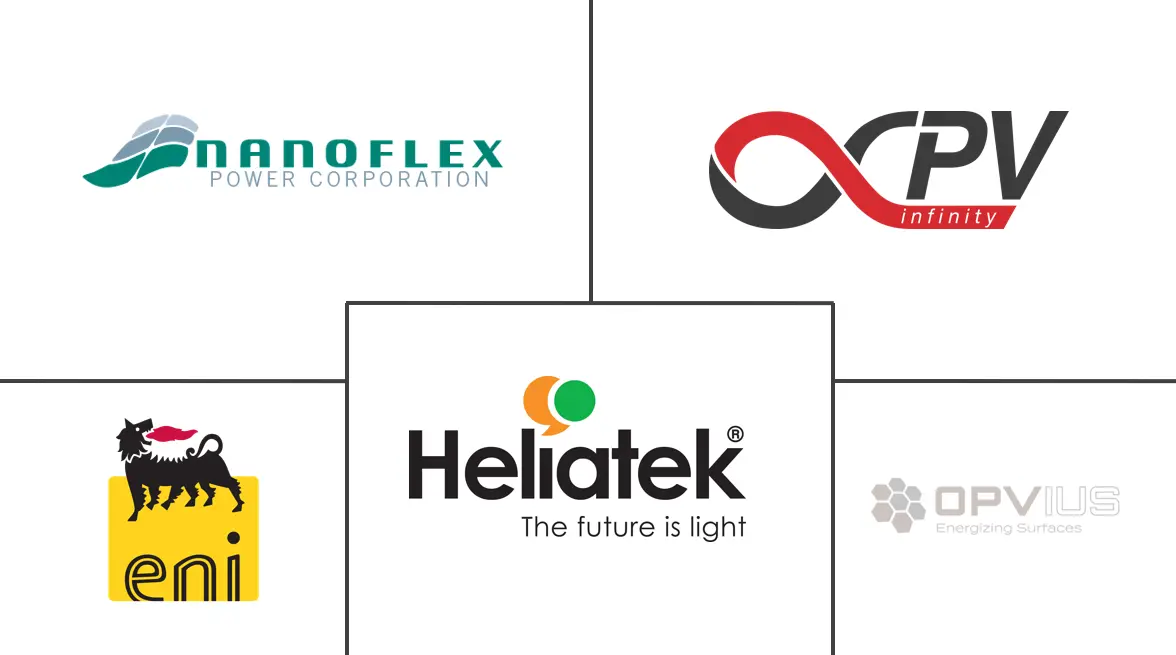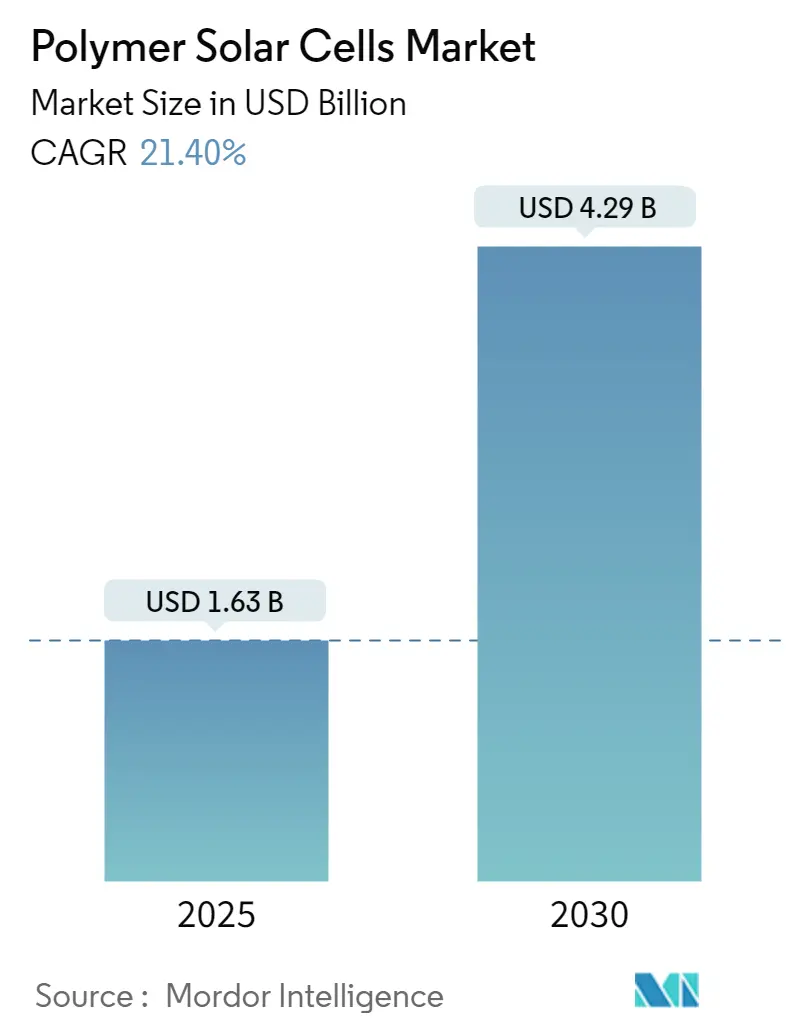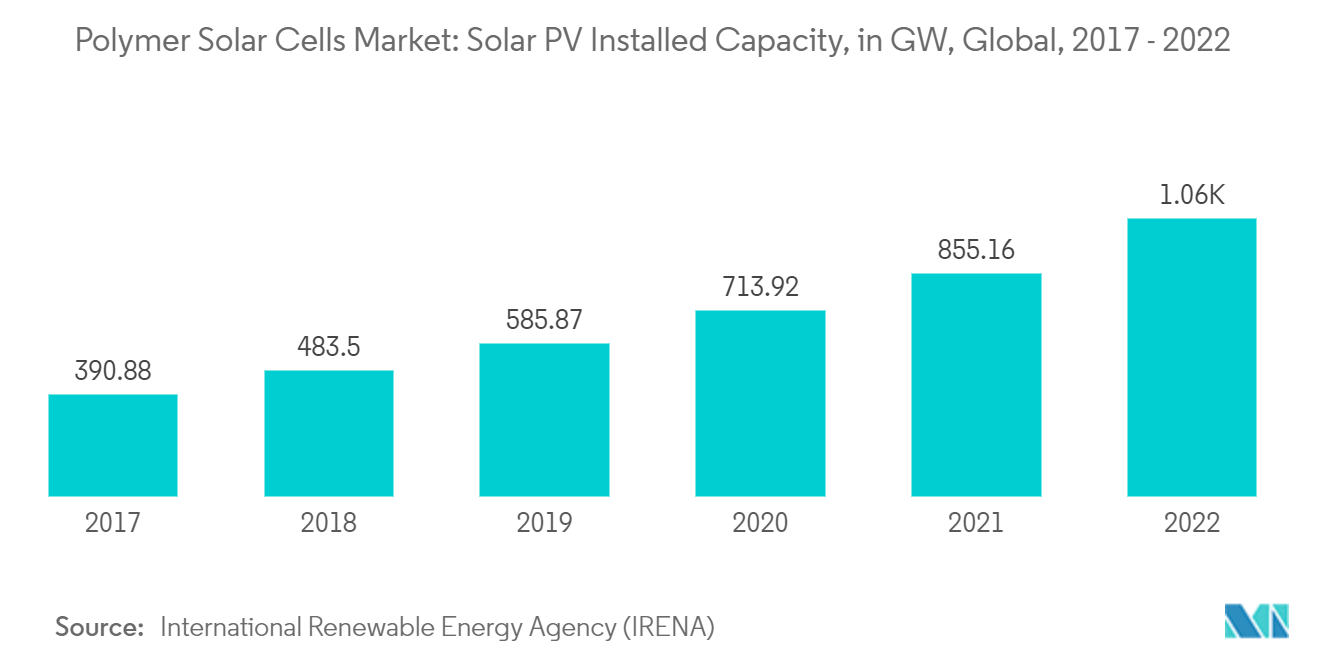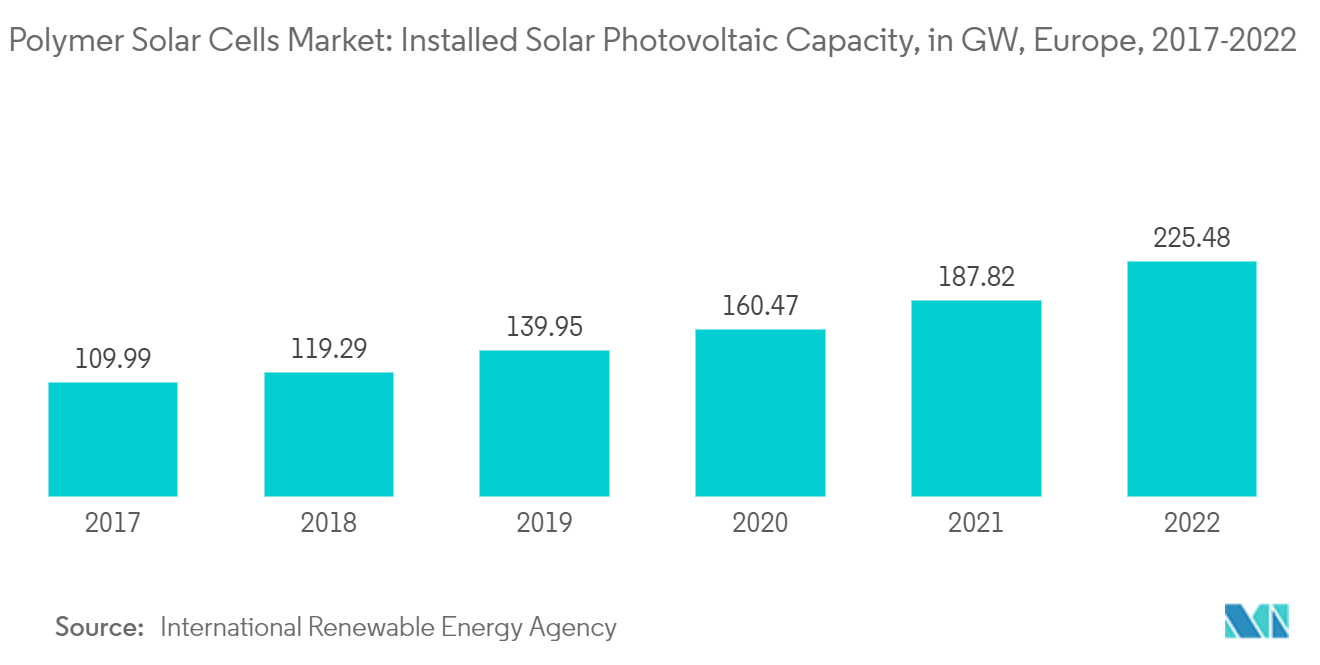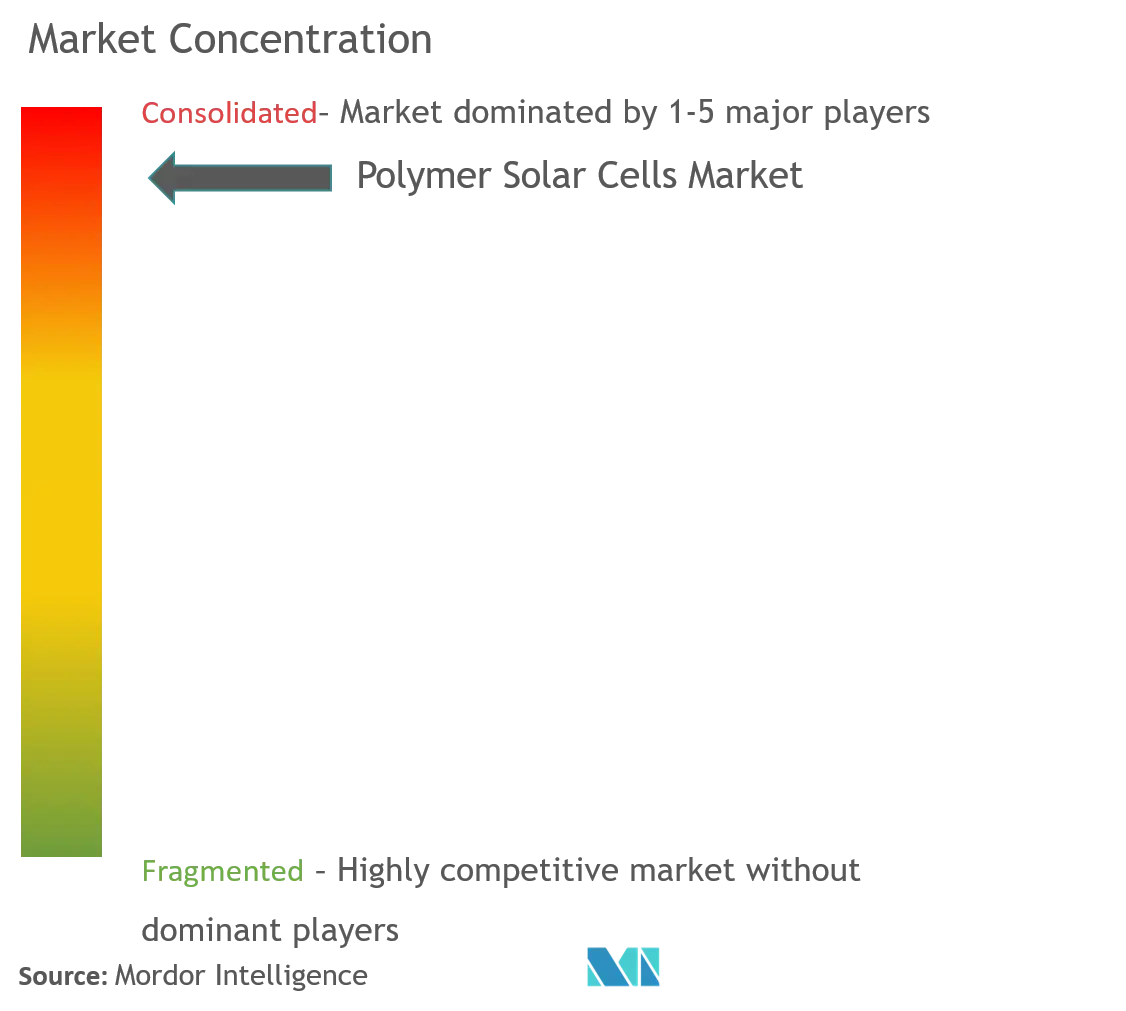Polymer Solar Cells Market Analysis
The Polymer Solar Cells Market size is estimated at USD 1.63 billion in 2025, and is expected to reach USD 4.29 billion by 2030, at a CAGR of 21.4% during the forecast period (2025-2030).
- Over the long term, technological advancements in polymer solar cell technology aimed at increasing conversion efficiency are expected to drive the market during the forecast period.
- On the flip side, the lower efficiency of polymer solar cells as compared to silicon solar cells is expected to hinder market growth during the forecasting period.
- Nevertheless, research and development into the development of new polymers with higher conversion efficiencies is expected to be a significant growth opportunity for the market beyond the forecast period.
Polymer Solar Cells Market Trends
Technological Advancements to Drive the Market
- Polymer solar cells, also called organic photovoltaic (OPV), are third-generation PV cells that use an organic polymer layer to convert light into electricity. Polymer solar cells are lightweight, flexible, customizable, and have a less adverse environmental impact.
- In 2022, global solar PV technology had a total installed capacity of around 1046.61 GW, growing by nearly 167.7% from 390.87 GW in 2017. With rapid improvements in PV technology in recent years, polymer solar cells achieved an efficiency of 18.42% in 2022 under lab conditions. In order to further increase efficiency, various organizations with different molecular structures are performing intensive research and are expected to penetrate the solar PV market in the near future.
- Polymer solar cells have a few advantages over silicon solar cells, like being lighter in weight, cheaper in cost, transparent, and having a longer lifetime (greater than 5000 hrs), but due to their low energy conversion, efficient commercial applications are very limited.
- As per Solarmer Energy Inc., the present efficiency of polymer solar cells is estimated to improve over time due to technological improvement, which is expected to provide efficient polymer molecular structure and make polymer solar cells more competitive in the market with silicon-based solar cells and other alternative solar cell technologies, driving the market during the forecast period.
Europe is Likely to Dominate the Market
- Europe was one of the largest markets for solar PV technology, with around 225.47 GW of solar PV installations as of 2022, up from 109.98 GW in 2017. With technological advancements, the region is doing various research projects to achieve cheaper and more flexible solar panels that can be installed on multiple surfaces.
- Companies like Heliatek GmbH and OPVIUS GmbH are developing polymer solar cells and have demonstrated a few projects in the region.
- The largest polymer or organic solar cell project was in France. It is called the BiOPV (Building Integrated Organic Photovoltaic). The project includes the installation of organic photovoltaics on the roof of around 500 square meters that generate nearly 23.8 MWh of electricity.
- As of 2023, a few other R&D projects were going on in the region. In October 2023, a French-Spanish research team developed organic photovoltaic modules embedded into plastic parts through high throughput injection molding. The researchers injected thermoplastic polyurethane into the modules and found it enhanced their mechanical stability while keeping a high flexibility. The researchers first created modules in roll-to-roll printing using a photoactive blend known as P3HT: O-IDTBR. This blend was chosen due to its morphological and thermal stability, which are relevant to the later injection molding process. The completion of R&D in various sectors and applications is expected to expand the market in the region during the forecast period.
Polymer Solar Cells Industry Overview
The polymer solar cells market is consolidated. Some of the key players in the market (in no particular order) include Eni SpA, NanoFlex Power Corporation, Infinity PV, OPVIUS GmbH, and Heliatek GmbH, among others.
Eni's research developed a technology that widens the horizons of integrated photovoltaics. Together with organic photovoltaic cells, perovskite cells can be made in semi-transparent thin film with reduced material costs and production techniques, enabling applications that have hitherto been impossible for conventional solar cells, such as embedding on building facades. Among other things, this application is promoted by recent international and EU directives in the area of energy efficiency for buildings. It is, therefore, destined to have an extensive range of uses.
Polymer Solar Cells Market Leaders
-
Eni SpA
-
NanoFlex Power Corporation
-
Infinity PV
-
OPVIUS GmbH
-
Heliatek GmbH
- *Disclaimer: Major Players sorted in no particular order
Polymer Solar Cells Market News
- July 2023: Researchers at the Indian Institute of Technology (IIT) Bhilai have developed a new technology in manufacturing a cost-effective and industry-friendly formulation for a ‘self-healing coating’ for solar cells. This new formulation permits the spontaneous healing of cracks within just five minutes, giving a promising solution to cure damage caused by hot and humid environmental temperatures.
- December 2022: IIT Kanpur scientists announced that they developed organic solar cell gadgets that combine the organic polymer PTB7 as a donor and PCBM as an acceptor, which can convert a steel roof into an energy-producing device more efficiently.
- June 2022: The University of Illinois Urbana-Champaign researchers announced that they had observed a biological property called chirality emerge in achiral conjugated polymers, which are used in designing flexible solar cells. Through their discovery, they could be able to enhance the charge capacity of the cells and increase access to renewable energy at an affordable price.
Polymer Solar Cells Industry Segmentation
Polymer solar cells, also known as organic solar cells, are a type of solar cell that uses organic materials, typically polymers, to convert sunlight into electricity. These cells are based on thin-film technology, which involves depositing thin layers of materials on a substrate, and have the potential to be more lightweight, flexible, and inexpensive to manufacture than traditional silicon-based solar cells.
The polymer solar cells market is segmented by geography (North America, Europe, Asia-Pacific, South America, and the Middle East and Africa). The report also covers the market size and forecasts for the polymer solar cells market across major regions, such as Asia-Pacific, North America, Europe, South America, the Middle East, and Africa. For each segment, market sizing and forecasts have been done based on revenue (USD).
| Geography | North America | United States | |
| Canada | |||
| Mexico | |||
| Europe | Germany | ||
| France | |||
| United Kingdom | |||
| Rest of Europe | |||
| Asia-Pacific | China | ||
| India | |||
| Japan | |||
| South Korea | |||
| Rest of Asia-Pacific | |||
| South America | Brazil | ||
| Argentina | |||
| Rest of South America | |||
| Middle-East and Africa | Saudi Arabia | ||
| United Arab Emirates | |||
| South Africa | |||
Polymer Solar Cells Market Research FAQs
How big is the Polymer Solar Cells Market?
The Polymer Solar Cells Market size is expected to reach USD 1.63 billion in 2025 and grow at a CAGR of 21.40% to reach USD 4.29 billion by 2030.
What is the current Polymer Solar Cells Market size?
In 2025, the Polymer Solar Cells Market size is expected to reach USD 1.63 billion.
Who are the key players in Polymer Solar Cells Market?
Eni SpA, NanoFlex Power Corporation, Infinity PV, OPVIUS GmbH and Heliatek GmbH are the major companies operating in the Polymer Solar Cells Market.
Which is the fastest growing region in Polymer Solar Cells Market?
Europe is estimated to grow at the highest CAGR over the forecast period (2025-2030).
Which region has the biggest share in Polymer Solar Cells Market?
In 2025, the Europe accounts for the largest market share in Polymer Solar Cells Market.
What years does this Polymer Solar Cells Market cover, and what was the market size in 2024?
In 2024, the Polymer Solar Cells Market size was estimated at USD 1.28 billion. The report covers the Polymer Solar Cells Market historical market size for years: 2019, 2020, 2021, 2022, 2023 and 2024. The report also forecasts the Polymer Solar Cells Market size for years: 2025, 2026, 2027, 2028, 2029 and 2030.
Our Best Selling Reports
Organic Solar Cell Industry Report
Statistics for the 2025 Polymer Solar Cells market share, size and revenue growth rate, created by Mordor Intelligence™ Industry Reports. Polymer Solar Cells analysis includes a market forecast outlook for 2025 to 2030 and historical overview. Get a sample of this industry analysis as a free report PDF download.

